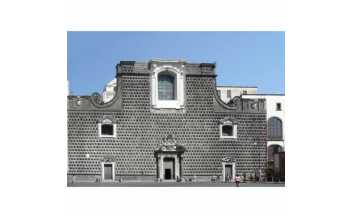“One can’t blame the Neapolitan for never wanting to leave his city, nor its poets singing its praises in lofty hyperboles: it would be wonderful even if a few more Vesuiviuses were to rise in the neighbourhood.” Johann Wolfgang von Goethe.
Thanks to its position on Italy’s southwest coast, Naples has been occupied since the 2nd-millennium BCE, when it was settled by Greeks.
Wander around its narrow streets and immerse yourself in centuries of architecture. There are no less than 448 churches in a variety of medieval, Renaissance, and baroque architectural styles. Make sure you see the Cathedral Santa Maria Assunta and Church of San Gregorio Armeno.
Overlooked by Mount Vesuvius, Pompeii and Herculaneum, the Roman cities destroyed in its eruption (79 CE), are just a short trip away.
Naples’ warm climate and its proximity to the sea means that you will find a spectacular array of fresh produce both at the market and in the city’s eateries. Don’t forget that Naples was the birthplace of the pizza. Naples’ long-standing association with the mafia has made it less popular with tourists than most other Italian cities. Whilst the rate of crime is still quite high and you should definitely take care of your possessions, the good thing is that it is relatively untouristy.
Activities
-
Basilica Reale Pontificia San Francesco di...
A church built in the style of the Roman Pantheon found in the Piazza del...
-
Botanical Garden of Naples
A 15-hectares garden filled with a variety of plants from around the world.
-
Capuano Castle, Naples, Campania, Italy
Castel Capuano is the second oldest castle in Naples, located in the historic...
-
-
Catacombs of San Gaudioso, Naples
The catacombs of San Gaudioso are an ancient cemetery area from the early...
-
-
Cathedral Santa Maria Assunta, Naples
Santa Maria Assunta is a Roman Catholic cathedral in Naples, southern Italy.
-
Certosa and San Martino Museum, Naples
Monastery housing baroque church with ceiling frescoes and a marble altar....
-
Chiesa del Gesù Nuovo, Naples
A 16th-century church filled with baroque art and covered in 17th-century...
-
-
-
Galleria Umberto I, Naples
Galleria Umberto I is a public shopping gallery in Naples, southern Italy. It...
-
Marine Protected Area Gaiola Underwater...
The underwater park of Gaiola is a 42-hectares protected marine area...
-
Monastery of Santa Chiara, Naples
The monastery of Santa Chiara is a monumental basilica in Naples, one of the...
-
Museo Cappella Sansevero, Naples
The Cappella Sansevero is a chapel located on Via Francesco de Sanctis 19,...
-
Sant'Elmo Castle, Naples
Castel Sant’Elmo, once called Paturcium, is a Medieval castlewhich dominates...





















